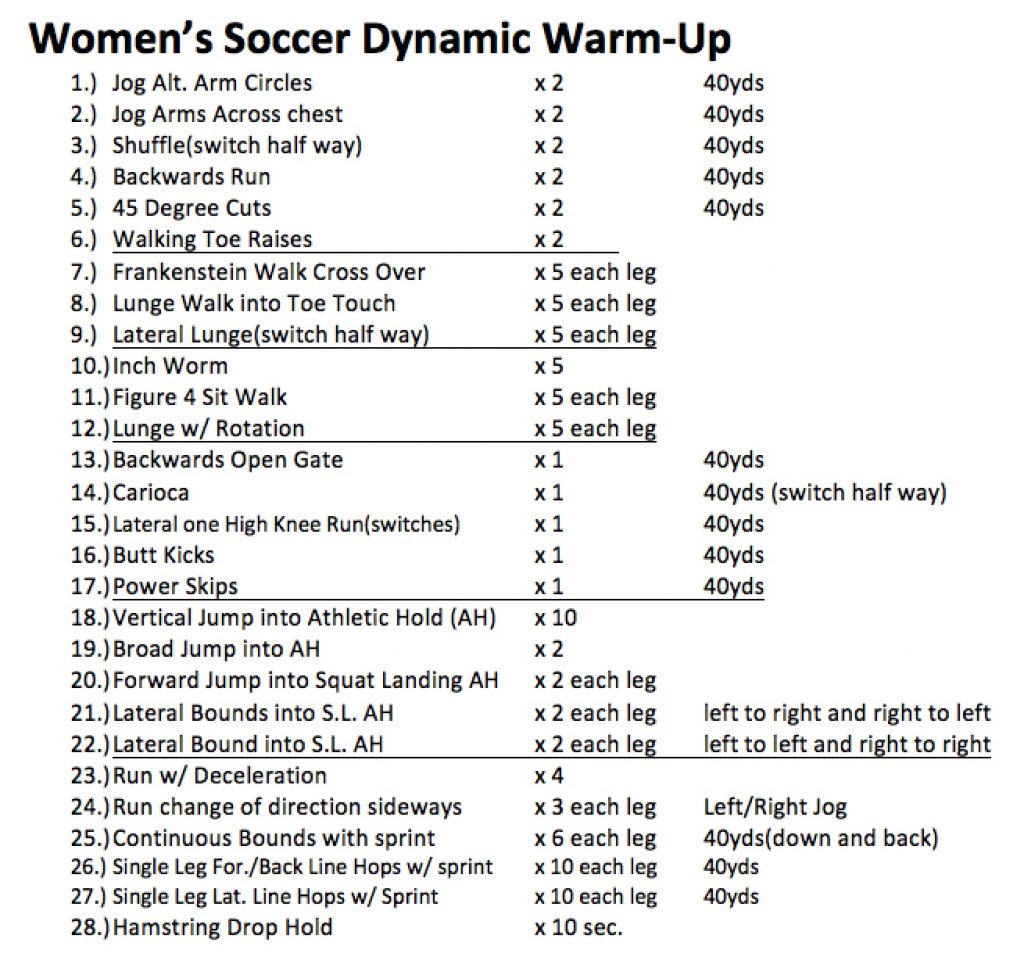
All Soccer pre-game or practice activity soccer warm-ups should be done with motion, there are many benefits from conducting a correct warm–up and many more negatives from staying with outdated ideas like static stretching. Much research has been done and it has shown over and over again that dynamic warm-ups are much more beneficial to an athlete prior to competition than static stretching. The dynamic warm-up can also assist in increasing a player’s overall level of ability as it aids in the player’s muscle memory, coordination, footwork, and overall agility and mobility. There is a place for static stretching and it is usually after a game or exercise to massage some the lactic acidity out of muscles.
A correct warm-up needs to increase blood flow and get the heart rate pumping at a faster rate. Soccer athletes need good circulation and increases in muscle and blood temperature, conducting a dynamic warm-up will help jump-start the cardiovascular system to appropriate levels for performance. The dynamic exercise also gets the brain working to concentrate on body motion and produces a focus for the impending tasks once the game starts. With this motion, the entire athlete’s body is activated including the Nervous System because the motion demands increased muscle and body control, awareness and coordination. As the body is warmed in this fashion the range of motion within muscles and joints they are protecting increases, this range of motion will decrease potential injury. The dynamic warm is likely to assist your players to produce the explosive energy and power needed to increase their abilities in the game.
The Dynamic warm–up is a form of stretching done while the body is in motion, it asks for quick stretches for short bursts. The idea of this stretching is to keep the players moving to increase body temperature, while increasing flexibility. Some of the exercises can be very ballistic and will assist in promoting the player’s ability to produce explosive power while still maintaining coordination, muscle memory and also control of their body.
The exercises used in the MOTI Sports Soccer Club warm-up are all soccer specific and are pivotal in reducing injury; all movements are well tested in their efficacy as warm up components. A gradual increase in demand is needed during the warm-up period the player’s body needs to get warm before too much is asked of it, the intensity of the work up should gradually increase during the session to include several flat out speed sprints of different distances.
Many of the best movements during a Soccer Dynamic Warm Up are multi-directional stutter steps with 1-2-3-4-5 steps. Rhythmical players who have this plyometric step sequence are usually found to have better ball handling skills, first touch, ability to change direction and pace of play.
The movement during the dynamic warm-up is best done across the width of the penalty box 44 yards on the large field; it should be done with players either stretched out from half way line to the top of the box or in pairs following each other. Try and stay out of the penalty box areas to avoid wear and tear on this high traffic zone of the field.
These moves and more can be found in the MOTI Soccer Training Platform and accessed by using the free MOTI Mobile App
Here are samples of appropriate moves:
Basic skip
Basic skip with arms clapping (above the head, out in front of face)
Basic skip with arms hands touching the chin and down
Basic skip with arms going backward looking to clap or touch behind the back
Basic skip with then a side shuffle step to the left then out to the right repeat
Jog with all the same arm movements as above
Jog with one leg coming up quickly with thigh parallel to the ground (single leg sprint motion)
Jog with one leg coming up entirely parallel to the ground like a hurdler
Jog touch left hand to the ground/ right hand to the ground/both hands
Jog call of # 1 is left hand to the ground #2 is right-hand #3 jumps in the air (header style with heading motion)
Jog high knees
Jog clap hands underneath hamstrings
Jog slap inside of your foot – right hand to left foot/left hand to right foot single stride set up
Jog slap the outside of your foot with the same hand
Jog backward
Jog backward with a slide step in each direction
Jog kick heels to touch backside or hands placed on players butt
Jog to the command of ‘1’ touches the ground with both hands
Jog to the command of ‘2’ is left-hand touches the ground
Jog to the command of ‘3’ is right hand touch the ground
Jog to the command of ‘red’ which is a jump off the left foot
Jog to the command of ‘blue’ which is a jump off the right foot
Jog to the command of ‘white’ which is a jump off both feet all jumps mirror a heading of the ball
Forward Shuffles where you open hips lift the leg high to the outside then rotate hips stepping in a 45-degree step over motion plant foot in neutral position repeat with the other leg
Hip crossover where player swings leg high upwards and inwards, rotating on the forward leg and pivoting on the planted leg, the player ends up facing the opposite direction. Repeat with the opposite leg.
Carioca is the regular cross over getting players to swing their arms gets even more rotation and flexibility
Carioca ‘TAPioca’ with very short steps and also very wide steps ‘WIDioca’ are both good alternate exercises
Walk skip kick leg high across the body – length of kick can be altered to be a side-foot volley, a goal kick a sharp strike on goal all working on correct technique
Side to side shuffle facing each other – need to go in both directions so leading foot changes
Side to side reverse so back to back – can be changed by the leader of the pack or coach
Side to side as above but with arms swinging crossed on chest past each other above the head
Side to side then chest bump with a partner directly in front of each other
Two-step run – skip and kick leg across body repeat from the other side
Two-step run – skip lift the trailing leg up and to the outside like a hurdler repeat each side
Two-step run – skip and lift the front leg back with thigh parallel to the ground
Forward Lunge left foot right foot
Forward Lunge left foot with an upper torso twist at the waist left and right repeat the right foot lunge
These can all be found on the MOTI Soccer Training Platform and accessed by using the free MOTI Mobile App
Special exercises’ ideal for the Women’s program with ACL Injury prevention;


I provide content, curriculums, topics and detailed coaching points to the MOTI Soccer Training Platform. I am pleased that a product like MOTI Soccer Training Platform is now available to all players, coaches and soccer enthusiasts.








